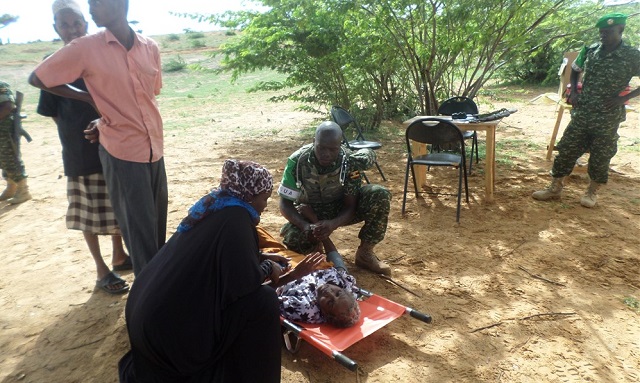
Kampala, Uganda | THE INDEPENDENT | A market for women, a football playground for youth, food supplies and health services, are some of the projects that Uganda Peoples Defence Forces (UPDF) contingent under the African Mission in Somalia (AMISOM) has started for folks in Somalia.
It’s these projects that have aided the friendship between UPDF soldiers and communities in a country ruined by war and anarchy. The Ugandan troops have served for 11 years.
With a force of about 5,700 soldiers in Somalia, Uganda is in charge of Banadir region which covers Mogadishu city and Lower Shabelle regions. The lower Shabelle region covers part of Somalia’s Indian Ocean coastline.
Uganda has three Battle Grounds in Somalia. The first is situated in Afgooye District, 30 kilometres from Mogadishu; the second in Ceelijaale, 125 kilometres from Mogadishu, and the third, in Barawe – south-west of lower Shabelle, 240 kilometres from Mogadishu.
From Ceelijaale, Our reporter observes that the interior of Somalia is poverty stricken. People have no access to basic needs such as health, water, food among others. Malnourished children, depressed and idle men and women living in fear of insecurity are what make living in the interior of Somalia quite depressing.
A glance at a sedentary old woman from a distance presents a striking resemblance of children who may also be indistinguishable from their parents. The people’s miseries are compounded by lack government visibility in the areas where they dwell.
In such a situation, UPDF soldiers are largely the source of basic needs for Somalis living in their operation zones.
Muhumuza Wilberforce Fred, a UPDF medic at Ceeljaale Battle Group headquarters says they attend to between 40 to 70 patients every day with ailments such as diarrhoea, tuberculosis, respiratory infections and diabetes, which is common among elderly men and women.
Muhumuza says they have not come across HIV and AIDS-related conditions. What is common, he explains is malnutrition-related ailments.
According to 2016 statistics from the Somalia National Aids Commission, Somalia has a total of 26,000 people living with HIV & AIDS with 51 percent of them being women.
This figure includes those living in Southern Somalia, self-proclaimed independent states of Puntland and Somaliland. HIV and AIDS is still considered a taboo subject as is directly associated with promiscuity in a country where 99 percent of the population profess Islam.
Fatumah Muhammad, who connects Somalis to UPDF soldiers as an interpreter says health is generally bad because there are no health facilities apart from AMISOM services. She explains that diarrhoea prevalence generally goes up in January and February. When people fall sick, Fatumah says, they consult AMISOM commanders for treatment.
Adjacent to Ceeljaale battle group headquarters is an open space, often used as a market every evening. According to Maj Joram Kabegambire, the initiative was started to help needy and widowed women to earn a living. Often, UPDF soldier use the same market to purchase merchandise
Maj Kabegambire says they are planning a tailoring project through which women will be given sewing machines.
The UPDF has also established two playgrounds for youth, a group categorized as the most vulnerable due to the possibility of being swayed into terrorism activities by Alshabaab.
In the absence of schools, these playgrounds have become a relief to youths for play soccer morning and evening. Soccer has also unified youths from different clans who were once adversaries., according to Maj Kabegambire.
******
URN
 The Independent Uganda: You get the Truth we Pay the Price
The Independent Uganda: You get the Truth we Pay the Price



